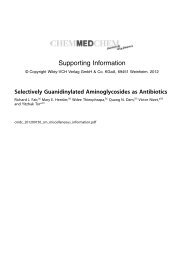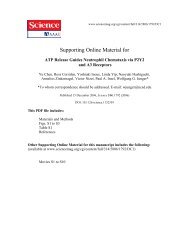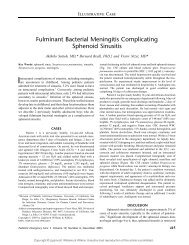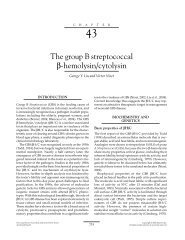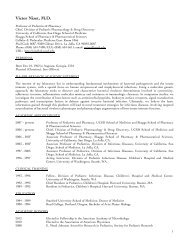BACTERIAL SEPSIS AND MENINGITIS - Nizet Laboratory at UCSD
BACTERIAL SEPSIS AND MENINGITIS - Nizet Laboratory at UCSD
BACTERIAL SEPSIS AND MENINGITIS - Nizet Laboratory at UCSD
Create successful ePaper yourself
Turn your PDF publications into a flip-book with our unique Google optimized e-Paper software.
[88] C. Eckhardt, et al., Transmission of methicillin-resistant Staphylococcus aureus<br />
in the neon<strong>at</strong>al intensive care unit from a p<strong>at</strong>ient with community-acquired<br />
disease, Infect. Control Hosp. Epidemiol. 24 (2003) 460–461.<br />
[89] S. Yee-Guardino, et al., Recognition and tre<strong>at</strong>ment of neon<strong>at</strong>al communityassoci<strong>at</strong>ed<br />
MRSA pneumonia and bacteremia, Pedi<strong>at</strong>r. Pulmonol. 43 (2008)<br />
203–205.<br />
[90] L. Saiman, et al., Hospital transmission of community-acquired methicillinresistant<br />
Staphylococcus aureus among postpartum women, Clin. Infect. Dis.<br />
37 (2003) 1313–1319.<br />
[91] M.D. David, et al., Community-associ<strong>at</strong>ed methicillin-resistant Staphylococcus<br />
aureus: nosocomial transmission in a neon<strong>at</strong>al unit, J. Hosp. Infect. 64 (2006)<br />
244–250.<br />
[92] S.M. Wang, et al., Staphylococcus capitis bacteremia of very low birth weight<br />
prem<strong>at</strong>ure infants <strong>at</strong> neon<strong>at</strong>al intensive care units: clinical significance and<br />
antimicrobial susceptibility, J. Microbiol. Immunol. Infect. 32 (1999) 26–32.<br />
[93] T. Strunk, et al., Neon<strong>at</strong>al immune responses to coagulase-neg<strong>at</strong>ive staphylococci,<br />
Curr. Opin. Infect. Dis. 20 (2007) 370–375.<br />
[94] S. Baumgart, et al., Sepsis with coagulase-neg<strong>at</strong>ive staphylococci in critically<br />
ill newborns, Am. J. Dis. Child. 137 (1983) 461.<br />
[95] S. Struthers, et al., A comparison of two versus one blood culture in the<br />
diagnosis and tre<strong>at</strong>ment of coagulase-neg<strong>at</strong>ive staphylococcus in the neon<strong>at</strong>al<br />
intensive care unit, J. Perin<strong>at</strong>ol. 22 (2002) 547–549.<br />
[96] R.T. Hall, et al., Characteristics of coagulase neg<strong>at</strong>ive staphylococci from<br />
infants with bacteremia, Pedi<strong>at</strong>r. Infect. Dis. J. 6 (1987) 377.<br />
[97] M. Otto, Virulence factors of the coagulase-neg<strong>at</strong>ive staphylococci, Front.<br />
Biosci. 9 (2004) 841–863.<br />
[98] A.L. Shiau, C.L. Wu, The inhibitory effect of Staphylococcus epidermidis slime<br />
on the phagocytosis of murine peritoneal macrophages is interferonindependent,<br />
Microbiol. Immunol. 42 (1998) 33–40.<br />
[99] J. Freeman, et al., Associ<strong>at</strong>ion of intravenous lipid emulsion and coagulaseneg<strong>at</strong>ive<br />
staphylococcal bacteremia in neon<strong>at</strong>al intensive care units, N. Engl.<br />
J. Med. 323 (1990) 301.<br />
[100] Centers for Disease Control and Prevention, Public health disp<strong>at</strong>ch:<br />
outbreak of listeriosis—Northeastern United St<strong>at</strong>es 2002, MMWR Morb.<br />
Mortal. Wkly. Rep. 51 (2002) 950.<br />
[101] K.M. Posfay-Barbe, E.R. Wald, Listeriosis, Semin. Fetal. Neon<strong>at</strong>al. Med.<br />
14 (2009) 228–233.<br />
[102] S.J. Schrag, et al., Risk factors for invasive, early-onset Escherichia coli infections<br />
in the era of widespread intrapartum antibiotic use, Pedi<strong>at</strong>rics<br />
118 (2006) 570–576.<br />
[103] J. Raymond, et al., Evidence for transmission of Escherichia coli from mother<br />
to child in l<strong>at</strong>e-onset neon<strong>at</strong>al infection, Pedi<strong>at</strong>r. Infect. Dis. J. 27 (2008)<br />
186–188.<br />
[104] S.M. Soto, et al., Compar<strong>at</strong>ive study of virulence traits of Escherichia coli clinical<br />
isol<strong>at</strong>es causing early and l<strong>at</strong>e neon<strong>at</strong>al sepsis, J. Clin. Microbiol.<br />
46 (2008) 1123–1125.<br />
[105] E. Bingen, et al., Phylogenetic analysis of Escherichia coli strains causing neon<strong>at</strong>al<br />
meningitis suggests horizontal gene transfer from a predominant pool<br />
of highly virulent B2 group strains, J. Infect. Dis. 177 (1998) 642.<br />
[106] S. Bonacorsi, E. Bingen, Molecular epidemiology of Escherichia coli causing<br />
neon<strong>at</strong>al meningitis, Int. J. Med. Microbiol. 295 (2005) 373–381.<br />
[107] C. Peigne, et al., The plasmid of Escherichia coli strain S88 (O45:K1:H7) th<strong>at</strong><br />
causes neon<strong>at</strong>al meningitis is closely rel<strong>at</strong>ed to avian p<strong>at</strong>hogenic E. coli plasmids<br />
and is associ<strong>at</strong>ed with high-level bacteremia in a neon<strong>at</strong>al r<strong>at</strong> meningitis<br />
model, Infect. Immun. 77 (2009) 2272–2284.<br />
[108] J.B. Robbins, et al., Escherichia coli K1 capsular polysaccharide associ<strong>at</strong>ed<br />
with neon<strong>at</strong>al meningitis, N. Engl. J. Med. 290 (1974) 1216.<br />
[109] G.H. McCracken Jr., et al., Rel<strong>at</strong>ion between Escherichia coli K1 capsular<br />
polysaccharide antigen and clinical outcome in neon<strong>at</strong>al meningitis, Lancet<br />
2 (1974) 246.<br />
[110] G.H. McCracken Jr., L.D. Sarff, Current st<strong>at</strong>us and therapy of neon<strong>at</strong>al<br />
E. coli meningitis, Hosp. Pract. 9 (1974) 57.<br />
[111] L.D. Sarff, et al., Epidemiology of Escherichia coli K1 in healthy and diseased<br />
newborns, Lancet 1 (1975) 1099.<br />
[112] G. Peter, J.S. Nelson, Factors affecting neon<strong>at</strong>al E. coli K1 rectal coloniz<strong>at</strong>ion,<br />
J. Pedi<strong>at</strong>r. 93 (1978) 866.<br />
[113] J.L. Burns, et al., Transcytosis of gastrointestinal epithelial cells by Escherichia<br />
coli K1, Pedi<strong>at</strong>r. Res. 49 (2001) 30–37.<br />
[114] Y. Xie, K.J. Kim, K.S. Kim, Current concepts on Escherichia coli K1 transloc<strong>at</strong>ion<br />
of the blood-brain barrier, FEMS Immunol. Med. Microbiol.<br />
42 (2004) 271–279.<br />
[115] S.H. Huang, M.F. Stins, K.S. Kim, Bacterial penetr<strong>at</strong>ion across the bloodbrain<br />
barrier during the development of neon<strong>at</strong>al meningitis, Microbes.<br />
Infect. 2 (2000) 1237–1244.<br />
[116] J.A. Hervás, et al., Increase of Enterobacter in neon<strong>at</strong>al sepsis: a twenty-twoyear<br />
study, Pedi<strong>at</strong>r. Infect. Dis. J. 20 (2001) 1134.<br />
[117] A. Gupta, Hospital-acquired infections in the neon<strong>at</strong>al intensive care unit—<br />
Klebsiella pneumoniae, Semin. Perin<strong>at</strong>ol. 26 (2002) 340.<br />
[118] S.K. Sood, D. Mulvihill, R.S. Daum, Intrarenal abscess caused by Klebsiella<br />
pneumoniae in a neon<strong>at</strong>e: modern management and diagnosis, Am. J. Perin<strong>at</strong>ol.<br />
6 (1989) 367.<br />
[119] S. Basu, et al., An unusual case of neon<strong>at</strong>al brain abscess following Klebsiella<br />
pneumoniae septicemia, Infection 29 (2001) 283.<br />
[120] H. Ozkan, et al., Perianal necrotizing fasciitis in a neon<strong>at</strong>e, Indian J. Pedi<strong>at</strong>r.<br />
64 (1997) 116.<br />
CHAPTER 6 Bacterial Sepsis and Meningitis<br />
269<br />
[121] R. Podschun, H. Acktun, J. Okpara, Isol<strong>at</strong>ion of Klebsiella planticola from<br />
newborns in a neon<strong>at</strong>al ward, J. Clin. Microbiol. 36 (1998) 2331.<br />
[122] G.L. Westbrook, et al., Incidence and identific<strong>at</strong>ion of Klebsiella planticola in<br />
clinical isol<strong>at</strong>es with emphasis on newborns, J. Clin. Microbiol. 38 (2000) 1495.<br />
[123] E. Leibovitz, et al., Sepsis <strong>at</strong> a neon<strong>at</strong>al intensive care unit: a four-year retrospective<br />
study (1989–1992), Isr. J. Med. Sci. 33 (1997) 734.<br />
[124] Y. Bell, et al., Neon<strong>at</strong>al sepsis in Jamaican neon<strong>at</strong>es, Ann. Trop. Paedi<strong>at</strong>r.<br />
25 (2005) 293–296.<br />
[125] E. Simeunovic, et al., Liver abscess in neon<strong>at</strong>es, Pedi<strong>at</strong>r. Surg. Int. 25 (2009)<br />
153–156.<br />
[126] C.L. Pessoa-Silva, et al., Extended-spectrum beta-lactamase-producing Klebsiella<br />
pneumoniae in a neon<strong>at</strong>al intensive care unit: risk factors for infection<br />
and coloniz<strong>at</strong>ion, J. Hosp. Infect. 53 (2003) 198.<br />
[127] E. Roilides, et al., Septicemia due to multiresistant Klebsiella pneumoniae in a<br />
neon<strong>at</strong>al unit: a case-control study, Am. J. Perin<strong>at</strong>ol. 17 (2000) 35.<br />
[128] P.W. Stone, et al., Attributable costs and length of stay of an extendedspectrum<br />
beta-lactamase-producing Klebsiella pneumoniae outbreak in a neon<strong>at</strong>al<br />
intensive care unit, Infect. Control Hosp. Epidemiol. 24 (2003) 601.<br />
[129] M.B. Kleiman, et al., Meningoencephalitis and compartmentaliz<strong>at</strong>ion of the<br />
cerebral ventricles caused by Enterobacter sakazakii, J. Clin. Microbiol.<br />
14 (1981) 352.<br />
[130] J. Willis, J.E. Robinson, Enterobacter sakazakii meningitis in neon<strong>at</strong>es,<br />
Pedi<strong>at</strong>r. Infect. Dis. J. 7 (1988) 196.<br />
[131] W.A. Bonadio, D. Margolis, M. Tovar, Enterobacter cloacae bacteremia in<br />
children: a review of 30 cases in 12 years, Clin. Pedi<strong>at</strong>r. 30 (1991) 310.<br />
[132] S. Harbarth, et al., Outbreak of Enterobacter cloacae rel<strong>at</strong>ed to understaffing,<br />
overcrowding, and poor hygiene practices, Infect. Control Hosp. Epidemiol.<br />
20 (1999) 598.<br />
[133] P.J. Wenger, et al., An outbreak of Enterobacter hormaechei infection and<br />
coloniz<strong>at</strong>ion in an intensive care nursery, Clin. Infect. Dis. 24 (1997) 1243.<br />
[134] C.L. da Silva, et al., Enterobacter hormaechei bloodstream infection <strong>at</strong> three<br />
neon<strong>at</strong>al intensive care units in Brazil, Pedi<strong>at</strong>r. Infect. Dis. J. 21 (2002) 175.<br />
[135] C. Iversen, et al., Cronobacter gen. nov., a new genus to accommod<strong>at</strong>e the<br />
biogroups of Enterobacter sakazakii, and proposal of Cronobacter sakazakii<br />
gen. nov., comb. nov., Cronobacter malon<strong>at</strong>icus sp. nov., Cronobacter turicensis<br />
sp. nov., Cronobacter muytjensii sp. nov., Cronobacter dublinensis sp. nov., Cronobacter<br />
genomospecies 1, and of three subspecies, Cronobacter dublinensis subsp.<br />
dublinensis subsp. nov., Cronobacter dublinensis subsp. lausannensis subsp. nov.<br />
and Cronobacter dublinensis subsp. lactaridi subsp. nov, Int. J. Syst. Evol.<br />
Microbiol. 58 (2008) 1442–1447.<br />
[136] N. Gurses, Enterobacter septicemia in neon<strong>at</strong>es, Pedi<strong>at</strong>r. Infect. Dis. J.<br />
14 (1995) 638.<br />
[137] A. Jain, et al., Prevalence of extended-spectrum beta-lactamase-producing<br />
gram-neg<strong>at</strong>ive bacteria in septicaemic neon<strong>at</strong>es in a tertiary care hospital,<br />
J. Med. Microbiol. 52 (2003) 421.<br />
[138] S. Townsend, E. Hurrell, S. Forsythe, Virulence studies of Enterobacter sakazakii<br />
isol<strong>at</strong>es associ<strong>at</strong>ed with a neon<strong>at</strong>al intensive care unit outbreak, BMC<br />
Microbiol. 8 (2008) 64.<br />
[139] H.N. Chen, et al., L<strong>at</strong>e-onset Enterobacter cloacae sepsis in very-low-birthweight<br />
neon<strong>at</strong>es: experience in a medical center, Pedi<strong>at</strong>r Neon<strong>at</strong>ol<br />
50 (2009) 3–7.<br />
[140] H.L. Muytjens, L.A.A. Kollee, Enterobacter sakazakii meningitis in neon<strong>at</strong>es:<br />
caus<strong>at</strong>ive role of formula? Pedi<strong>at</strong>r. Infect. Dis. J. 9 (1990) 372.<br />
[141] F.R. Noriega, et al., Nosocomial bacteremia caused by Enterobacter sakazakii<br />
and Leuconostoc mesenteroides resulting from extrinsic contamin<strong>at</strong>ion of infant<br />
formula, Pedi<strong>at</strong>r. Infect. Dis. J. 9 (1990) 447.<br />
[142] D. Drudy, et al., Enterobacter sakazakii: an emerging p<strong>at</strong>hogen in powdered<br />
infant formula, Clin. Infect. Dis. 42 (2006) 996–1002.<br />
[143] Cronobacter species isol<strong>at</strong>ion in two infants—New Mexico, 2008, MMWR<br />
Morb. Mortal. Wkly. Rep. 58 (2009) 1179–1183.<br />
[144] T.F. Fok, et al., Risk factors for Enterobacter septicemia in a neon<strong>at</strong>al unit:<br />
case-control study, Clin. Infect. Dis. 27 (1998) 1204.<br />
[145] A.T. Tresoldi, et al., Enterobacter cloacae sepsis outbreak in a newborn unit<br />
caused by contamin<strong>at</strong>ed total parenteral nutrition solution, Am. J. Infect.<br />
Control. 28 (2000) 258.<br />
[146] H.S. Cheng, et al., Outbreak investig<strong>at</strong>ion of nosocomial Enterobacter cloacae<br />
bacteraemia in a neon<strong>at</strong>al intensive care unit, Scand. J. Infect. Dis. 32 (2000)<br />
293.<br />
[147] T.I. Doran, The role of Citrobacter in clinical disease of children: review,<br />
Clin. Infect. Dis. 28 (1999) 384.<br />
[148] D.R. Graham, J.D. Band, Citrobacter diversus brain abscess and meningitis in<br />
neon<strong>at</strong>es, JAMA 245 (1981) 1923.<br />
[149] D.R. Graham, et al., Epidemic nosocomial meningitis due to Citrobacter<br />
diversus in neon<strong>at</strong>es, J. Infect. Dis. 144 (1981) 203.<br />
[150] A.M. Kaplan, et al., Cerebral abscesses complic<strong>at</strong>ing neon<strong>at</strong>al Citrobacter<br />
freundii meningitis, West. J. Med. 127 (1977) 418.<br />
[151] F.Y.C. Lin, et al., Outbreak of neon<strong>at</strong>al Citrobacter diversus meningitis in a<br />
suburban hospital, Pedi<strong>at</strong>r. Infect. Dis. J. 6 (1987) 50.<br />
[152] S.C. Eppes, et al., Recurring ventriculitis due to Citrobacter diversus: clinical<br />
and bacteriologic analysis, Clin. Infect. Dis. 17 (1993) 437.<br />
[153] S.D. Foreman, et al., Neon<strong>at</strong>al Citrobacter meningitis; p<strong>at</strong>hogenesis of cerebral<br />
abscess form<strong>at</strong>ion, Ann. Neurol. 16 (1984) 655.<br />
[154] J.G. Morris, et al., Molecular epidemiology of neon<strong>at</strong>al meningitis due to<br />
Citrobacter diversus: a study of isol<strong>at</strong>es from hospitals in Maryland, J. Infect.<br />
Dis. 154 (1986) 409.



